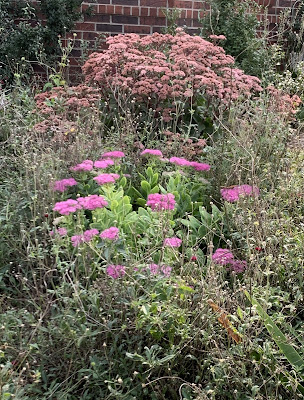Sometimes, I wonder what I'm running here on the prairie; a garden or a zoo? Just one of my game cameras took over a thousand "snaps" in the past two months. I'll give you a brief sampling to show you the drama you're probably missing in your own garden, and in the spirit of true suspense, I'll save the most exciting until the last.
Of course, many of the pictures are of ProfessorRoush and deer; of the beautiful Bella sniffing the ground (upper right) and minding anything but her own business, and of the goofy neighbor's dog who uses my yard as a personal toilet (left) almost every day.
I seem to have gained a red squirrel here, frantically gathering pecans and acorns in my yard. I've never had a squirrel live here before but he's somewhere out there because I had hundreds of pictures of him in this bunch. I'll have to figure out which tree he's nesting in.
Birds are plentiful in the pictures, including this bluebird sweeping in for a landing and the red house finch, below, who is taking a break in the shade. There are also pictures of other finches, meadowlarks, and sparrows temporarily on the ground here.
And the smaller wildlife is well represented. I'll spare you the pictures of the mouse and the chipmunk and the rabbits and the raccoon who come in for candid closeups once in a while.
Nightlife? Oh, there's plenty around. It abounds, around, you might say. I could do without this striped skunk (
Mephitis mephitis), even if it is just passing through, and then there is this creature below skulking through the night, which I think is a gray fox (
Urocyon
cinereoargenteus). I saw him much better just this morning at dawn, crossing the yard heading for the hills to my west. He's been in other views on both cameras periodically all summer.

You wouldn't think that a stationery camera snapping pictures based on motion would be good for anything but occasional still shots, and yet this one captured, at one point, the drama present in most every garden. I'll show you the full capture of these pictures, because the time stamps are important. Here, at 12:13:24 pm on 10/02/2020, is my red squirrel, lower right corner, out playing in the grass as it has a hundred times before:
And then at 12:16:31, we see this hawk sweep in, a fraction of an inch from grabbing the squirrel that is diving for the goldenrod and safety at the edge of the bed. Are we witnessing the fury of nature?
At 12:16:32, there's the hawk, sitting in the grass. What does he have clutched in those talons? Have I seen the last of my red squirrel?
I only had to wait until the next picture; 12:19:49, and the red squirrel is back out again, doing it's squirrley-things. I think I'd have waited a little longer, myself, to be sure the hawk was gone.
I apologize about the picture-heavy post, but it is the best glimpse of life out there in the garden that I can give you. Please try not to spend the next week wondering, as I will, if the squirrel made it to winter and what else may be sneaking around out there in the garden.





















































